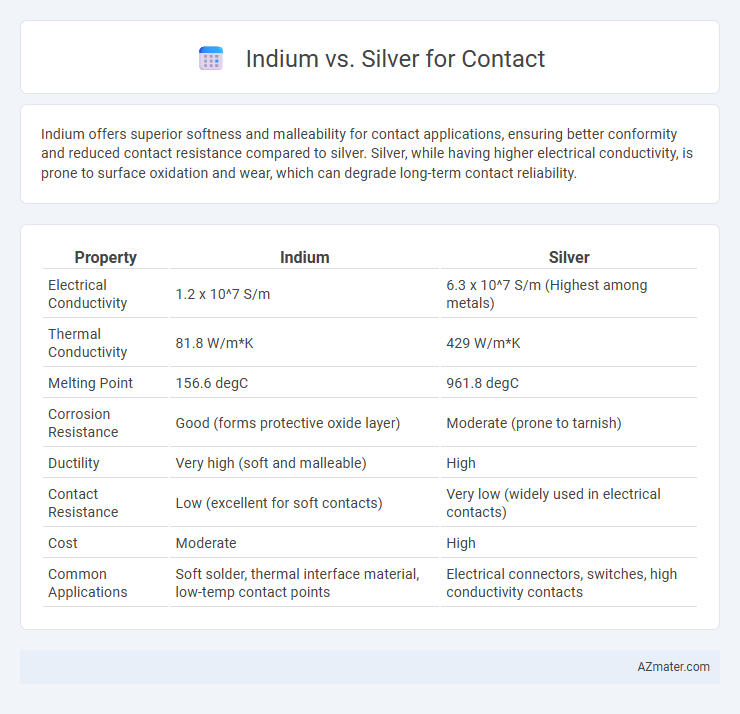Indium offers superior softness and malleability for contact applications, ensuring better conformity and reduced contact resistance compared to silver. Silver, while having higher electrical conductivity, is prone to surface oxidation and wear, which can degrade long-term contact reliability.
Table of Comparison
| Property | Indium | Silver |
|---|---|---|
| Electrical Conductivity | 1.2 x 10^7 S/m | 6.3 x 10^7 S/m (Highest among metals) |
| Thermal Conductivity | 81.8 W/m*K | 429 W/m*K |
| Melting Point | 156.6 degC | 961.8 degC |
| Corrosion Resistance | Good (forms protective oxide layer) | Moderate (prone to tarnish) |
| Ductility | Very high (soft and malleable) | High |
| Contact Resistance | Low (excellent for soft contacts) | Very low (widely used in electrical contacts) |
| Cost | Moderate | High |
| Common Applications | Soft solder, thermal interface material, low-temp contact points | Electrical connectors, switches, high conductivity contacts |
Indium vs Silver: An Overview
Indium offers superior softness and malleability compared to silver, enabling better conformity and lower contact resistance in electrical connections. Silver provides excellent electrical conductivity and corrosion resistance but is prone to oxidation and wear under mechanical stress, leading to reduced contact reliability. In high-reliability applications, indium's ability to maintain stable, low-resistance contacts under varying environmental conditions often makes it the preferred choice over silver.
Electrical Conductivity Comparison
Indium offers lower electrical conductivity compared to silver, with silver having an exceptional conductivity of approximately 63 x 10^6 S/m, while indium typically measures around 1.2 x 10^7 S/m. Silver's superior conductivity makes it ideal for high-performance electrical contacts where minimal resistance is crucial. However, indium provides better adhesion and corrosion resistance, which can be advantageous in specific contact applications despite its lower conductivity.
Thermal Conductivity Differences
Indium exhibits a thermal conductivity of approximately 86 W/m*K, significantly lower than silver's 429 W/m*K, affecting heat dissipation in electronic contacts. While silver's superior thermal conductivity ensures rapid heat transfer and reduced thermal buildup, indium's lower value limits its efficiency in high-heat applications. However, indium provides excellent ductility and conformity for reliable mechanical contact despite its thermal conductivity disadvantage compared to silver.
Mechanical Properties and Durability
Indium offers exceptional softness and superior ductility compared to silver, enabling better conformity to surface irregularities and reducing contact resistance under mechanical stress. Silver exhibits higher tensile strength and hardness, providing durability against wear and deformation in high-load applications but is prone to oxidation which can degrade contact performance over time. The choice between indium and silver for electrical contacts depends on balancing indium's enhanced mechanical compliance and oxidation resistance against silver's robust durability and electrical conductivity under harsh conditions.
Oxidation and Corrosion Resistance
Indium offers superior oxidation and corrosion resistance compared to silver, forming a stable oxide layer that prevents further degradation. Silver, while highly conductive, is prone to tarnishing and corrosion in the presence of sulfur compounds, compromising long-term contact reliability. Indium's ability to maintain electrical integrity under harsh environmental conditions makes it a preferred choice for durable electrical contacts.
Cost Effectiveness and Availability
Indium offers superior cost effectiveness over silver for electrical contacts due to its lower price volatility and more abundant global reserves, reducing supply chain risks. Silver, despite its excellent conductivity, commands higher prices driven by industrial demand and precious metal market fluctuations. Availability of indium is more stable, making it a practical choice for large-scale contact manufacturing where budget constraints are critical.
Solderability and Ease of Application
Indium offers superior solderability compared to silver due to its low melting point of 156.6degC, enabling easier wetting and bonding with various metals, especially in sensitive electronic applications. Silver, with a higher melting point of 961.8degC, requires more energy-intensive soldering processes, potentially causing thermal stress on components. Indium's malleability and ductility facilitate easier application in thin, uniform layers, making it ideal for delicate and flexible contacts where precision is critical.
Common Industry Applications
Indium is widely used in electronics for soft, malleable contacts in semiconductors and thermal interface materials, while silver remains the preferred choice for high-conductivity electrical contacts in automotive and telecommunications industries. Indium contacts provide excellent resistance to corrosion and oxidation, making them ideal for aerospace and cryogenic applications. Silver's superior electrical conductivity and durability support its extensive use in circuit breakers, switches, and RF connectors.
Environmental and Health Considerations
Indium offers a lower environmental impact compared to silver due to its greater abundance and less toxic mining processes, reducing ecological disturbance. Silver extraction often involves hazardous chemicals like cyanide, posing significant health risks to workers and surrounding communities. Indium's biocompatibility and lower toxicity make it a safer choice for contact materials in electronics and medical applications.
Which Metal is Best for Electrical Contacts?
Indium offers superior corrosion resistance and excellent softness, providing reliable electrical contacts with low contact resistance, especially in low-force or delicate applications. Silver boasts the highest electrical conductivity among metals, making it ideal for high-current, high-performance contacts but is more prone to tarnishing and wear. In choosing the best metal for electrical contacts, indium excels in durability and oxidation resistance, while silver is preferred for maximum conductivity and efficiency.

Infographic: Indium vs Silver for Contact
 azmater.com
azmater.com